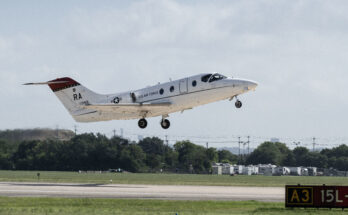The primary objective of the U.S. Army’s Future Attack Reconnaissance Aircraft (FARA) program is to produce a next-generation scout aircraft to replace the previously retired Bell OH-58 Kiowa Warrior. FARA is organized under the Future Vertical Lift (FVL) umbrella, an overarching initiative to replace the Army’s aging helicopter fleet with advanced vertical takeoff and landing aircraft capable of a wide range of mission sets. As a FVL component, FARA specifically aims to fulfill the armed reconnaissance and forward scouting role for Army aviation units. The Bell 360 Invictus and Lockheed Martin’s Sikorsky Raider X prototypes will compete for final selection by the Army for planned service introduction in 2030.
Origin and Timeline
FARA first began when the Army effectively retired the last OH-58 Kiowa scout helicopter in 2017, leaving a gap in the forward area reconnaissance mission. Since then, the scouting role has been primarily filled by the medium-lift AH-64 Apache. By October 2018, the Army’s need for a new age dedicated light replacement helicopter had materialized in a solicitation to industry for prototype designs. The original solicitation states the requirement for a small, fast, light-attack aircraft capable of armed reconnaissance and security that would be a “knife fighter” for Army aviation, with an initial goal of prototype flight in 2023.
In April 2019, under FARA phase one, the Army awarded five companies Other Transaction Authority for Prototype (OTAP) agreements for initial design: AVX Aircraft Co partnered with L3Harris, Bell Helicopter Textron Inc, The Boeing Company, Karem Aircraft Inc, and Lockheed Martin-owned Sirkorsky Aircraft Corp. By March 2020, the Army had announced its decision to cut the contenders down to only Bell and Sikorsky to build flying demonstrators for flight in 2023. Under the initial solicitation, the two finalists were to earn $735 million each over the FY20 to FY23 period.
Three years later, to the month, Bell and Sikorsky reported their respective prototypes were 95 percent complete and waiting to receive General Electric’s T901 engine for installation. GE, which signed a $517 million engineering, manufacturing and development (EMD) contract for the Army’s Improved Turbine Engine Program (ITEP) to outfit UH-60 Black Hawks, AH-64 Apaches, and FARA helicopters, has experienced myriad development setbacks. The delays due to COVID-19 and supply chain disruptions have pushed back a first flight of the prototypes at least a year, into late 2024.
Budget
Research and development funding for the FARA program falls under the Aviation Advanced Development line as a FVL sub-listing in the Department of Defense’s annual budget request and was first appropriated in FY20 at $398.3 million. In FY22, program funding for FARA peaked at $633.2 million. Congressional allocations then dipped to $468.8 million in FY23. The White House requested slightly less for FY24 with an ask of $458 million. However, total funding requests for FVL overall did increase from FY23 to FY24.
FARA budget totals include a line titled “FARA Ecosystem,” which directs funding toward development of FVL-wide requirements, including Modular Open Systems Approach (MOSA) and Air Launched Effects (ALE) which will integrate with FVL aircraft. The MOSA feature for FARA aims to provide the Army with platform components that will allow cost savings through interoperability. ALE includes small air-fired kinetic and non-kinetic systems that provide extended sensor and weapons reach while delivering both lethal and non-lethal effects. FARA funding requests will likely increase dramatically over the next several years, with a total five-year Future Years Defense Program (FYDP) projection of just over $4.1 billion.
Prototype Finalists
The U.S. Army’s main stipulations for the FARA design include a main rotor diameter no larger than 40 feet, a maximum speed of at least 180 knots, and a maximum gross weight of 14,000 pounds, and it must utilize the ITEP engine.

Bell’s 360 Invictus helicopter design has its roots in the larger commercial Bell 525 Relentless. The single-engine tandem-seat helicopter features a four-blade main rotor and stub wings along the airframe to provide additional lift and reduce power requirements at high-speed flight. For munitions, the 360 Invictus will carry a turreted 20mm cannon under the nose and accommodate internal weapons mounting. The aircraft also features retractable landing gear to assist in eliminating drag. A senior Bell FARA official noted the helicopter’s high speed and ability to “carry as much as an Apache.”

Sikorsky’s Raider X, which was developed from the smaller S-97, is a compound helicopter featuring two stacked four-blade coaxial rotors and a rear pusher propeller enabling speeds above 200 knots. Like its Bell competitor, the Raider X boasts a nose-mounted 20mm cannon, retractable landing gear, and internal weapons bays. The design incorporates a tandem side-by-side cockpit, in contrast to the Bell configuration. Aerodynamically, the Raider X’s coaxial main rotor system allows flight characteristics similar to fixed-wing aircraft, most notably high-speed flight and the ability to accelerate and decelerate with a level nose attitude.
Development and Outlook
FARA’s progress sits at a standstill until the ITEP engine is delivered to Bell and Sikorsky. Once received, the prototypes will require ground testing prior to a first flight, but Bell officials believe they will achieve those milestones in 2024. The Army’s selection of either the 360 Invictus or Raider X will occur in 2025 with an EMD contract for the winner expected the following year.
Given the ITEP engine manufacturing delays and a concerning April 2023 GAO report on FVL, there is good reason to doubt the FARA program will meet its projected goals. The Government Accountability Office noted the three portfolio programs of FVL did not incorporate credible cost estimates or meet industry standards of practice for acquisitions. In June, a House subcommittee questioned the Army’s delay in completing an analysis of alternatives (AOA) study for FARA, while the Army’s acquisition chief noted the AOA was among the factors contributing to the program’s slow progress.
However, the Army’s advances on the Future Long Range Assault Aircraft (FLRAA) program, recent FARA budget requests, and the service’s need to address its air reconnaissance capability gap suggest the program will move onward. While production forecasting is highly speculative, the Army did indicate a desire to put at least 300 FARA aircraft into service. Considering Bell’s and Sikorsky’s historical success of military helicopter exports, FARA will likely see overseas sales sometime after the Army’s initial order. While FARA’s headway has been rocky at times, the upcoming prototype flights and ultimate prime manufacturer selection will indeed stabilize and secure the program’s future.
Forecast International’s Rotorcraft Forecast provides complete coverage of the worldwide rotorcraft market, ranging from two-seat pistons such as the Robinson R22 up to giant turbine helicopters such as the Russian Helicopters Mi-26. Also included is coverage of tiltrotor aircraft such as the Leonardo AW609 and Bell/Boeing V-22 Osprey. Both the military and civil markets are covered. An annual subscription includes nearly 60 reports, most with a 10-year unit production forecast. Five Market Segment Analyses explore the trends and dynamics impacting the various segments of the rotorcraft market, and discuss longer-term programs such as the U.S. military’s Future Vertical Lift project. Click here for more information.
A former naval officer and helicopter pilot, Jon covers a range of Forecast International reports and products, drawing on his 10-year background in military aviation, operations, and education. His previous military assignments include multiple overseas deployments supporting operations in the Arabian Gulf, NATO exercises, and humanitarian missions. Jon’s work is also influenced by his time as a former Presidential Management Fellow and international trade specialist at the Department of Commerce.
Before joining Forecast International, Jon also served as an NROTC instructor and Adjunct Assistant Professor at the University of Texas, where he taught undergraduate courses on naval history, navigation, defense organization, and naval operations and warfare. A lifelong reader and learner, his academic and professional interests include aviation, political and military history, national defense and security, and foreign area studies.




